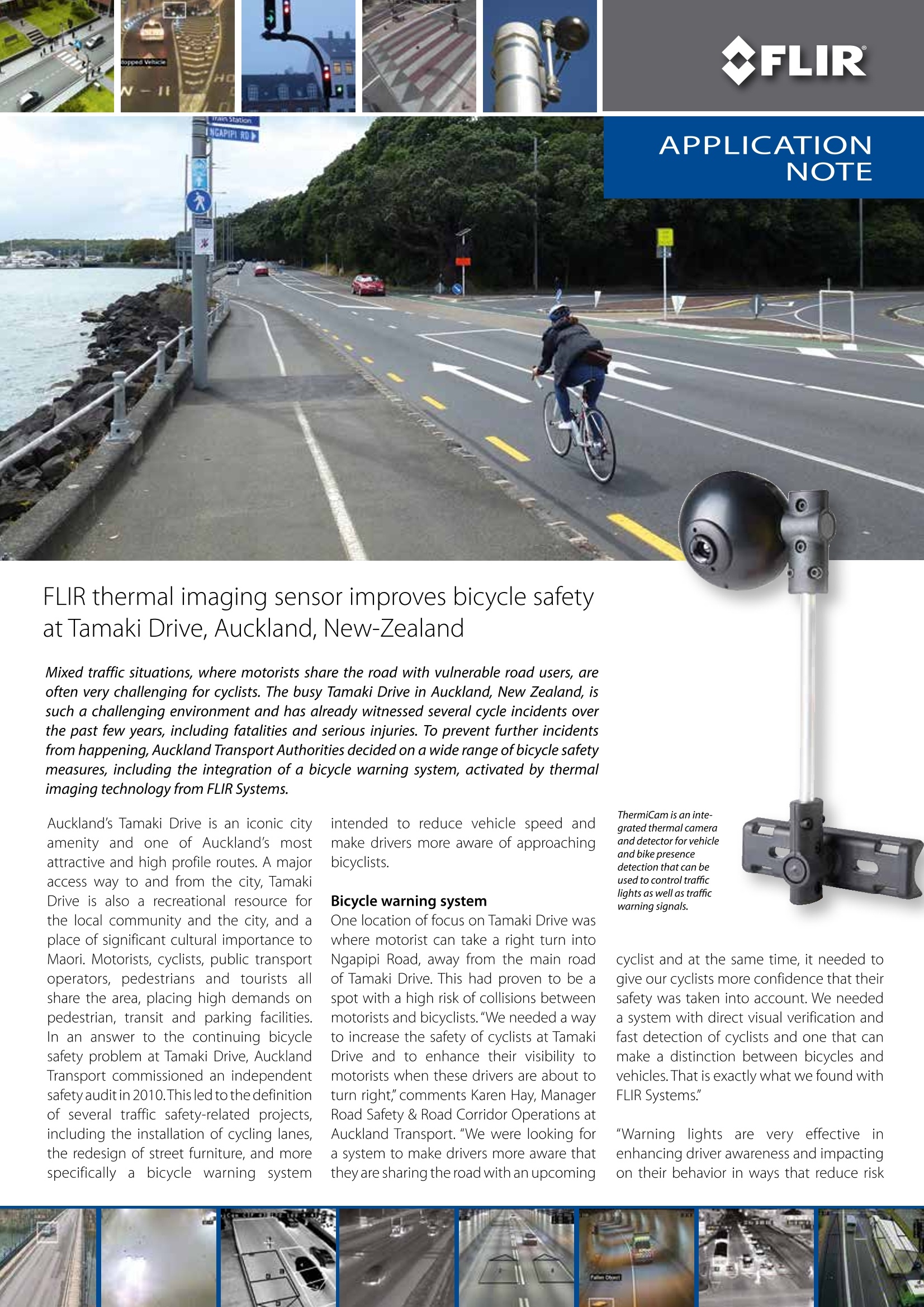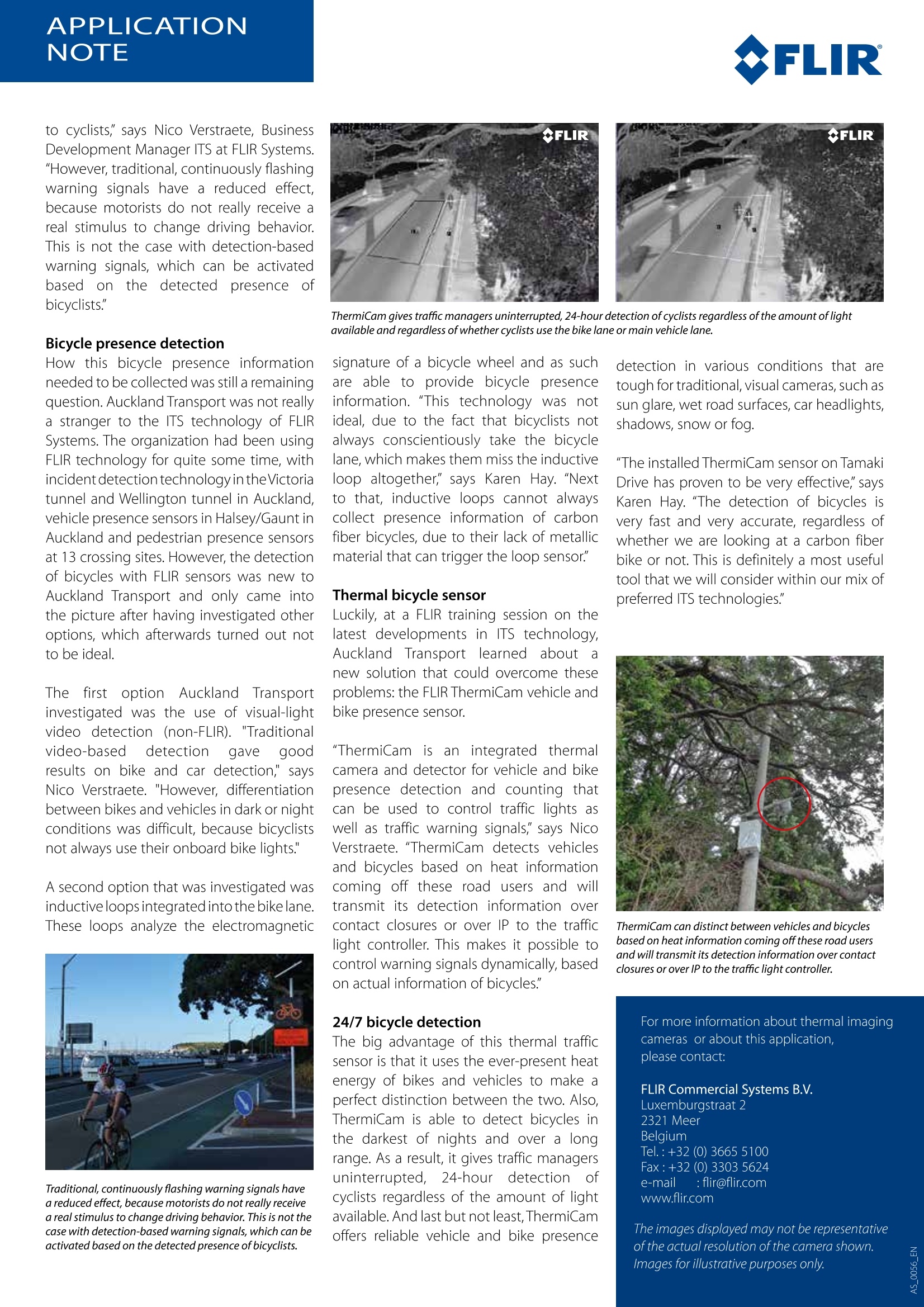方案详情文
智能文字提取功能测试中
APPLICATIONNOTEFLIR GAPIPIRDE APPLICATIONNOTE FLIR thermal imaging sensor improves bicycle safetyat Tamaki Drive, Auckland, New-Zealand Mixed traffic situations, where motorists share the road with vulnerable road users, areoften very challenging for cyclists. The busy Tamaki Drive in Auckland, New Zealand, issuch a challenging environment and has already witnessed several cycle incidents overthe past few years, including fatalities and serious injuries. To prevent further incidentsfrom happening,Auckland Transport Authorities decided on a wide range of bicycle safetymeasures, including the integration of a bicycle warning system, activated by thermalimaging technology from FLIR Systems. Auckland's Tamaki Drive is an iconic cityamenity and one of Auckland's mostattractive and high profile routes. A majoraccess way to and from the city, TamakiDrive is also a recreational resource forthe local community and the city, and aplace of significant cultural importance toMaori. Motorists, cyclists, public transportoperators, pedestrians and tourists allshare the area, placing high demands onpedestrian, transit and parking facilities.ln an answer to the continuing bicyclesafety problem at Tamaki Drive, AucklandTransport commissioned an independentsafetyaudit in 2010.This led to the definitionof several traffic safety-related projects,including the installation of cycling lanes,the redesign of street furniture, and morespecifically a bicycle warningsystem intended to reduce vehicle speed andmake drivers more aware of approachingbicyclists. Bicycle warning system One location of focus on Tamaki Drive waswhere motorist can take a right turn intoNgapipi Road, away from the main roadof Tamaki Drive. This had proven to be aspot with a high risk of collisions betweenmotorists and bicyclists."We needed a wayto increase the safety of cyclists at TamakiDrive and to enhance their visibility tomotorists when these drivers are about toturn right"comments Karen Hay, ManagerRoad Safety & Road Corridor Operations atAuckland Transport."We were looking fora system to make drivers more aware thatthey are sharing the road with an upcoming ThermiCam is an inte-grated thermal cameraand detector for vehicleand bike presencedetection that can beused to control trafficlights as well as trafficwarning signals. cyclist and at the same time, it needed togive our cyclists more confidence that theirsafety was taken into account. We neededa system with direct visual verification andfast detection of cyclists and one that canmake a distinction between bicycles andvehicles.That is exactly what we found withFLIR Systems. "Warning llights are very effective inenhancing driver awareness and impactingon their behavior in ways that reduce risk DEO to cyclists, says Nico Verstraete, BusinessDevelopment Manager ITS at FLIR Systems."However, traditional, continuously flashingwarning signals have a reduced effect,because motorists do not really receive areal stimulus to change driving behavior.This is not the case with detection-basedwarning signals, which can be activatedbased onnthe detected presence ofbicyclists. Bicycle presence detection How this bicycle presence informationneeded to be collected was still a remainingquestion. Auckland Transport was not reallya stranger to the ITS technology of FLIRSystems. The organization had been usingFLIR technology for quite some time, withincidentdetection technology intheVictoriatunnel and Wellington tunnel in Auckland,vehicle presence sensors in Halsey/Gaunt inAuckland and pedestrian presence sensorsat 13 crossing sites. However, the detectionof bicycles with FLIR sensors was new toAuckland Transport and only came intothe picture after having investigated otheroptions, which afterwards turned out notto be ideal. The irst option Auckland Transportinvestigated was the use of visual-lightvideo detection (non-FLIR)."Traditionalvideo-based detection gave goodresults on bike and car detection" saysNico Verstraete. "However, differentiationbetween bikes and vehicles in dark or nightconditions was difficult, because bicyclistsnot always use their onboard bike lights" A second option that was investigated wasinductiveloops integrated intothe bikelane.These loops analyze the electromagnetic Traditional, continuously flashing warning signals havea reduced effect, because motorists do not really receivea real stimulus to change driving behavior. This is not thecase with detection-based warning signals, which can beactivated based on the detected presence of bicyclists. ThermiCam gives traffic managers uninterrupted, 24-hour detection of cyclists regardless of the amount of lightavailable and regardless of whether cyclists use the bike lane or main vehicle lane. signature of a bicycle wheel and as suchare able to provide bicycle presenceinformation. “This technology was notideal, due to the fact that bicyclists notalways conscientiously take the bicyclelane, which makes them miss the inductiveloop altogether, says Karen Hay. "Nextto that, inductive loops cannot alwayscollect presence information of carbonfiber bicycles, due to their lack of metallicmaterial that can trigger the loop sensor" Thermal bicycle sensor Luckily, at a FLIR training session on thelatest developments in ITS technology,Auckland Transport ltlearned aaboutanew solution that could overcome theseproblems: the FLIR ThermiCam vehicle andbike presence sensor. "ThermiCam isisanintegrated thermalcamera and detector for vehicle and bikepresence detection and counting thatcan be used to control traffic lights aswell as traffic warning signals says NicoVerstraete. "ThermiCam detects vehiclesand bicycles based on heat informationcoming off these road users and willtransmit its detection information overcontact closures or over IP to the trafficlight controller. This makes it possible tocontrol warning signals dynamically, basedon actual information of bicycles. 24/7 bicycle detection The big advantage of this thermal trafficsensor is that it uses the ever-present heatenergy of bikes and vehicles to make aperfect distinction between the two. Also,ThermiCam is able to detect bicycles inthe darkest of nights and over a longrange. As a result, it gives traffic managersuninterrupted,24-hour detectionofcyclists regardless of the amount of lightavailable. And last but not least,ThermiCamoffers reliable vehicle and bike presence detection in various conditions that aretough for traditional, visual cameras, such assun glare, wet road surfaces, car headlights,shadows,snow or fog. “The installed ThermiCam sensor on TamakiDrive has proven to be very effective, saysKaren Hay. "The detection of bicycles isvery fast and very accurate, regardless ofwhether we are looking at a carbon fiberbike or not. This is definitely a most usefultool that we will consider within our mix ofpreferred ITS technologies. ThermiCam can distinct between vehicles and bicyclesbased on heat information coming off these road usersand will transmit its detection information over contactclosures or over IP to the traffic light controller. For more information about thermal imagingcameras or about this application, please contact: FLIR Commercial Systems B.V. Luxemburgstraat 2 2321 MeerBelgiumTel.:+32 (0) 3665 5100Fax : +32 (0) 3303 5624 e-mail : flir@flir.com www.flir.com The images displayed may not be representativeofthe actual resolution of the camera shown.lmages for illustrative purposes only. Bicycle presence detection How this bicycle presence information needed to be collected was still a remaining question. Auckland Transport was not reallya stranger to the ITS technology of FLIR Systems. The organization had been usingFLIR technology for quite some time, with incident detection technology in the Victoria tunnel and Wellington tunnel in Auckland, vehicle presence sensors in Halsey/Gaunt in Auckland and pedestrian presence sensors at 13 crossing sites. However, the detection of bicycles with FLIR sensors was new to Auckland Transport and only came into the picture after having investigated otheroptions, which afterwards turned out not to be ideal.
关闭-
1/2

-
2/2

产品配置单
菲力尔中国为您提供《交通安全中自行车行驶安全检测方案(红外热像仪)》,该方案主要用于自行车中自行车行驶安全检测,参考标准《暂无》,《交通安全中自行车行驶安全检测方案(红外热像仪)》用到的仪器有null。
我要纠错
相关方案


 咨询
咨询

